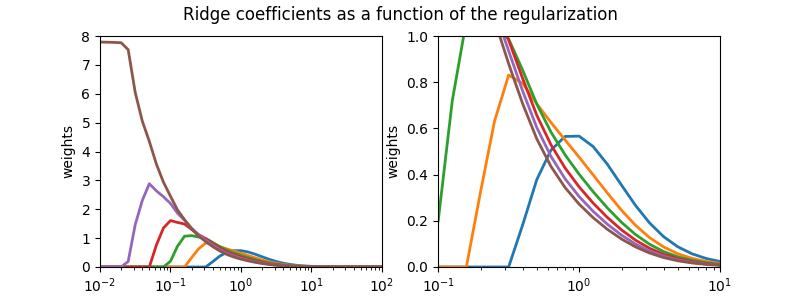2.1. Nonnegative Least Squares Regression¶
Nonnegative Least Squares Regression solves the equation \(Ax=b\) subject to the constraint that the coefficients \(x\) be nonnegative:
NonnegativeLinear will take in its fit method
arrays X, y and will store the coefficients \(w\) in its
coef_ member:
>>> from mcmodels.regressors import NonnegativeLinear
>>> reg = NonnegativeLinear()
>>> reg.fit ([[0, 0], [1, 1], [2, 2]], [0, 1, 2])
NonnegativeLinear()
>>> reg.coef_
array([1.0, 0.0]
2.1.1. Nonnegative Ridge Regression¶
The equation \(Ax=b\) is said to be ill-conditioned if the columns of A are nearly linearly dependent. Ill-conditioned least squares problems are highly sensitive to random errors and produce estimations with high variance as a result.
We can improve the conditioning of \(Ax=b\) by imposing a penalty on the size of the coefficients \(x\). Using the L2 norm as a measure of size, we arrive at Tikhonov Regularization, also known as ridge regression:
We can incorporate a nonnegativity constraint and rewrite the formula above as a quadratic programming (QP) problem:
where
which we can solve using any number of quadratic programming solvers.
As with NonnegativeLinear, NonnegativeRidge will take in its
fit method arrays X, y and will store the coefficients
\(w\) in its coef_ member:
>>> from mcmodels.regressors import NonnegativeRidge
>>> reg = NonnegativeRidge(alpha=1.0)
>>> reg.fit ([[0, 0], [1, 1], [2, 2]], [0, 1, 2])
NonnegativeRidge(alpha=1.0, solver='SLSQP')
>>> reg.coef_
array([0.45454545, 0.45454545])
2.1.2. Nonnegative Lasso or Nonnegative Elastic Net¶
Both the non-negative Lasso and the non-negative Elastic Net regressors are currently implemented in the scikit-learn package:
- If one wishes to perform non-negative Lasso regression, see sklearn.linear_model.Lasso or sklearn.linear_model.lasso_path and pass the parameters fit_intercept=False, positive=True
- If one wishes to perform non-negative Elastic-Net regression, see sklearn.linear_model.ElasticNet, or sklearn.linear_model.enet_path, and pass the parameters fit_intercept=False, positive=True
